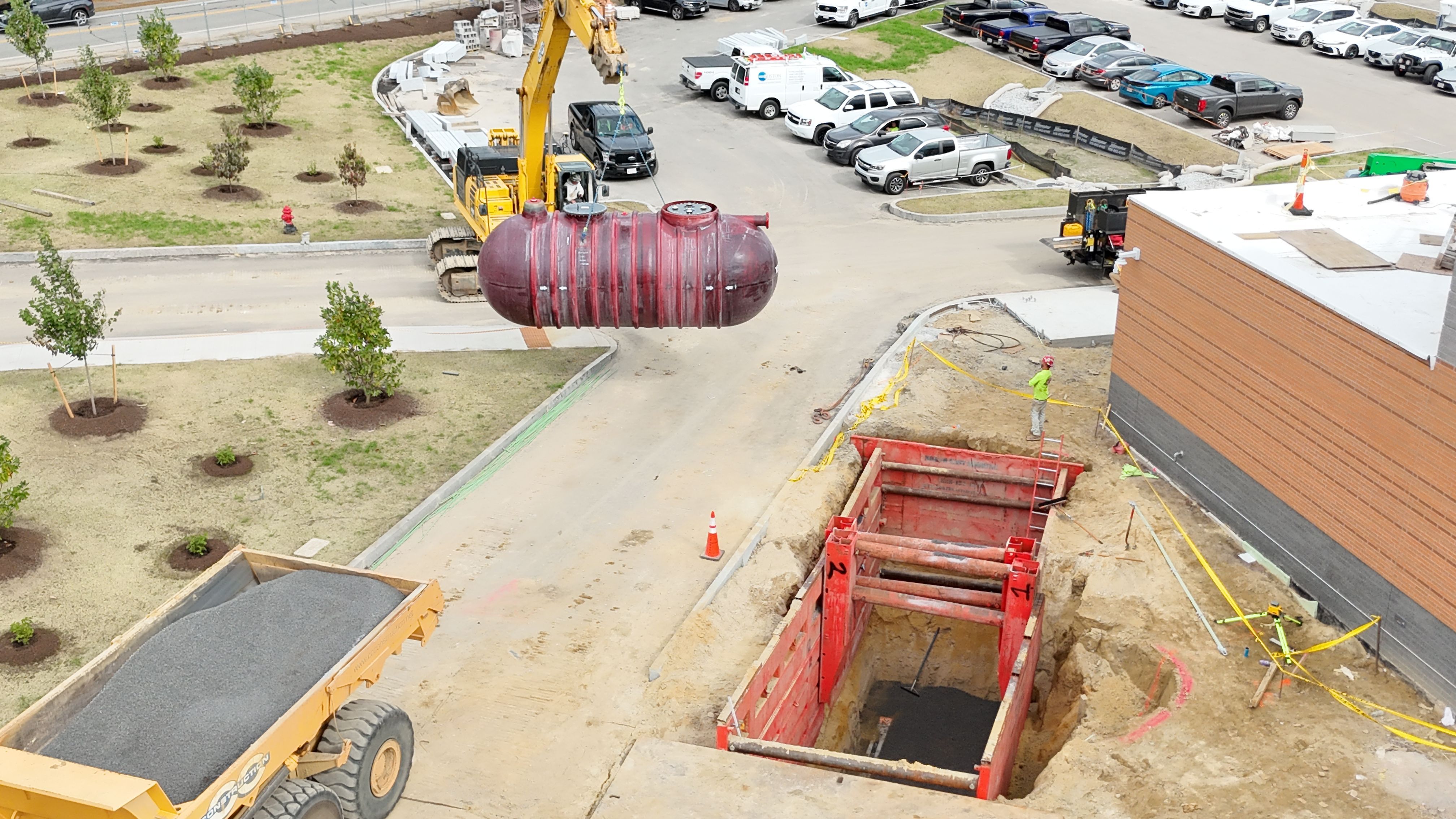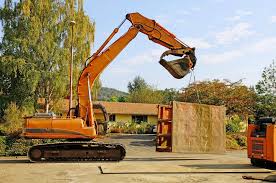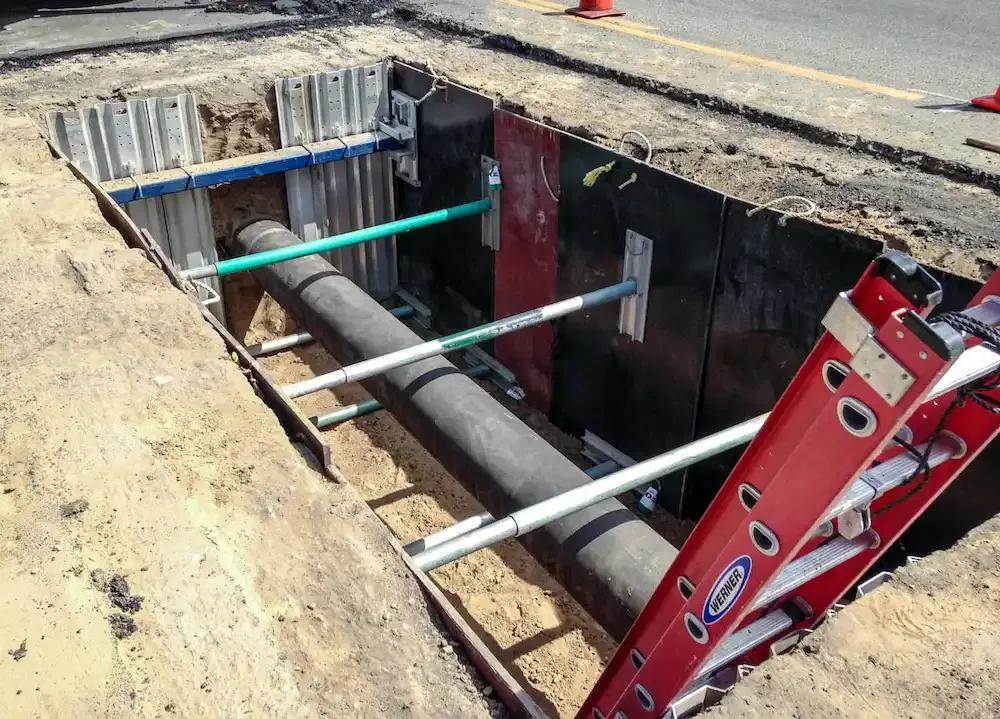What Is a Trench Box?
A trench box is a safety structure placed inside an open trench to protect workers from cave-ins. Also known as a trench shield, it’s made of two steel or aluminum sidewalls held apart by adjustable spreader bars.
Trench boxes are used during utility installation, pipeline work, sewer repair, and other jobs that require workers to enter deep, unsupported trenches. They do not prevent soil movement — instead, they contain it, creating a safe area inside the trench.
The box is usually placed by a machine such as an excavator. Once set, workers can enter the shielded space to complete tasks below grade level without being exposed to collapsing walls.
lapsing walls.
How Do Trench Boxes Work?
Trench boxes are designed to resist the pressure of soil and debris from the trench walls. They sit directly in the excavation and create a protective zone where workers can safely operate.
Each box has two parallel panels, usually made of steel or aluminum, spaced apart with adjustable spreaders. These panels absorb lateral pressure from the trench walls, allowing the soil to press against the box instead of collapsing into the trench.
Boxes are installed and removed using equipment like excavators or backhoes. Depending on the jobsite, they may be lowered into place before digging deeper or slid down as excavation progresses.
Trench boxes don’t stop the ground from moving — they contain it. That’s why they’re critical for protecting crews during underground work.
When Should You Use a Trench Box?
You should use a trench box any time your trench is deeper than five feet, unless the excavation is made entirely in stable rock. That’s the minimum requirement under OSHA trench safety regulations. But in practice, most contractors use trench boxes for shallower depths too, especially in wet or unstable soil.
Trench boxes are essential during:
- Sewer and utility installations
- Water line repairs
- Underground electrical conduit placement
- Storm drain or manhole construction
They’re especially important on jobs where workers are in the trench for extended periods or when soil conditions are unpredictable.
If your project involves any open excavation, it’s best to plan ahead. Learn more about trench box rental services in your area and how to get the right equipment delivered to your jobsite.
Benefits of Using Trench Boxes on the Jobsite
Using trench boxes is more than a compliance issue — it’s a smart, protective step that benefits your entire crew and project.
1. Worker Safety The primary benefit is protecting workers from trench collapses. Even shallow trenches can cave in without warning. A trench box provides a secure barrier between workers and unstable soil.
2. OSHA Compliance Using trench protection systems like trench boxes ensures your site follows federal regulations. This helps you avoid penalties, stop-work orders, or liability in case of an accident.
3. Reduced Downtime When crews feel safe, work gets done faster. Trench boxes create a controlled environment, which speeds up installation, inspections, and backfilling.
4. Lower Risk of Costly Incidents Trench collapses can lead to injuries, lawsuits, and major delays. Using a trench box helps prevent all three, protecting both people and your budget.
5. Versatility Across Jobsites Whether you’re working on a city street, a pipeline corridor, or a utility trench in rocky ground, trench boxes come in various sizes and materials to match your conditions.
What Happens If You Don’t Use One?
Working in an unprotected trench is one of the most dangerous things you can do on a jobsite. Without a trench box or another protective system, the walls of a trench can collapse with no warning — and the results are often fatal.
According to OSHA, a single cubic yard of soil can weigh over 3,000 pounds. If that falls on a worker, there’s almost no time to react. Most trench-related deaths happen in unprotected excavations.
Beyond safety, not using a trench box can lead to serious legal and financial consequences. OSHA fines for trenching violations can reach thousands of dollars per day, per infraction. You may also face lawsuits, insurance issues, or work stoppages.
Simply put: skipping a trench box puts people, budgets, and timelines at risk.
Choosing the Right Trench Box for the Job
Not every trench box is the same. The right one depends on your trench depth, soil conditions, and the size of the excavation.
Here’s what to consider
- Trench Depth and Width: Deeper or wider trenches require stronger, steel trench boxes. Shallow jobs may work better with aluminum shields.
- Soil Type: Loose, wet, or sandy soil calls for more robust protection. Know your soil classification before choosing a box.
- Access Space: Working in tight city streets or near utilities? Modular or lightweight boxes may be the best fit.
- Project Duration: For short-term needs, renting is often the most efficient solution. Long-term, repeat jobs may justify buying equipment.
If you're unsure what size or type you need, our team can help. Visit our trench shoring product page to compare options or explore our trench box rental services by location to see availability near you.
Final Takeaway: Why Every Contractor Should Understand Trench Boxes
Trench boxes aren’t optional — they’re essential. They protect lives, reduce risk, and help projects move forward without unexpected delays or legal issues.
Every contractor involved in excavation work should understand what trench boxes are, how they work, and when they’re required. Making the right decision before a shovel hits the ground can prevent injuries, fines, or worse.
If your next job involves open trenching, make trench safety a priority from day one. For guidance on equipment or rental options, visit our trench box rental page or contact us for a quote.
Frequently Asked Questions
A trench box is used to protect workers from trench collapses during underground construction. It creates a safe working space inside an open trench.
OSHA requires protective systems for trenches deeper than 5 feet. However, if the soil is unstable or the risk is high, a trench box may still be recommended at 4 feet.
A trench box is a passive shield that protects workers inside the trench. Shoring, on the other hand, applies pressure to actively support trench walls and prevent collapse.
Yes, OSHA requires trench protection systems like trench boxes for excavations deeper than 5 feet unless the trench is in stable rock.
Yes, trench boxes can be stacked vertically, but only if they are designed and rated for it. Always follow the manufacturer’s guidelines.
Yes, trench boxes are available in various widths, lengths, and panel thicknesses to match different trench depths and soil conditions.




